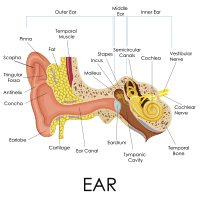They Cost WHAT?

Far and away, the most common question I get day to day is “Why are hearing aids so expensive?” The answer is complex, but I will try to explain.
One of the main factors affecting the price of hearing aids is ‘market potential’. Hearing aids are considered a high tech/low volume product. In the United States roughly 32% of people with hearing loss wear hearing aids. Currently Annual hearing aid sales in the US is slightly less than 4 million units. In the US there are about 35 million people with hearing loss. Even if ALL of them bought hearing aids this year, that wouldn’t amount to the number of iPhones sold in the 4th quarter of 2018. But as already noted, only about 1/3 of people who could utilize hearing aids actually do. So as market potentials go, hearing aids are a pretty small.
Another significant part of the cost of aids is R&D. Hearing aids are VERY sophisticated devices. A not well known fa
A Poem
Lena said: Sven, when answering questions you bumble
Sven said :“Lena, that because you always mumble”
“Oh come on Sven - you don’t hear me”
Sven said: “well then, don’t talk unless your near me”
Once again Mary asked John to repeat
John finds it easier to retreat
Their TV is too loud, but Mary is too proud
John wanders off in defeat
Jack says “Kids today talk too fast”
Jill says “they spoke the same speed in the past”
she says “it’s you that has trouble
Jack, You live in a bubble. Won’t you do something about it at last?”
All these folks exhibit denial
the result puts their conversations on trial
Hearing loss isn’t a solo complication
it affects everyones participation.
Yet, for the patient that is not all-
hearing loss causes isolation and withdrawal
But , the Research is long, and the evidence is strong
seeking treatment can help them belong
On Migration

I am going to talk about migration, but not the kind you’re thinking. This is an article about epithelial migration. Particularly epithelial migration in the ear canal.
An ear canal, averages one inch long and one-third inch in diameter. It flows up and back in a gentle ’S’ curve. The skin on the outer half is pretty much like the rest of the skin on your body. If damaged, it will heal in the usual manner . Normal skin cells develop in deep tissue and migrate upward, until they reach the surface, die, and fall off. The term for shedding dead skin cells is desquamation.
The skin of the inner ear canal is different. It is more keratin based, similar to your hair and finger nails. This inner half is often referred to as the bony portion of you ear canal because it is surrounded by bone, while the outer half is surrounded by cartilage.
When this keratin grows, it starts at a basal location and migrates laterally, this is called e
Wax In … Wax Out
Wax In - The most common subject that any hearing health care worker gets asked about is ear wax. Usually with a negative connotation. Something along the lines of “yuck…ear wax”.
First and foremost what we need to realize is; Earwax is good! Normal amounts of ear wax produce numerous benefits. There is the obvious one of trapping and preventing small particles from reaching the eardrum. The substance also serves to moisturize and lubricate the sensitive skin of the ear canal. An invisible, yet very important function of ear wax is infection protection. The antimicrobial functions of ear wax are due primarily to the Ph balance, the lipid content and the enzyme lysozyme.
The proper name for ear wax is cerumen (Sir-oo-men). Cerumen is a naturally-produced secretion. It is made up of a mixture of water-soluble viscous secretions, sebum from sebaceous glands and less viscous secretions from modified apocrine sweat glands. The consistency
Protect Your Hearing
In 1981, OSHA implemented new requirements to protect all workers in general industry (e.g. the manufacturing and the service sectors) for employers to implement a Hearing Conservation Program where workers are exposed to a time weighted average noise level of 85 dBA or higher over an 8 hour work shift.
In 1986 RONALD REAGAN, proclaimed the month of May as Better Hearing and Speech Month, and and called upon the people of the United States “to observe this month with appropriate ceremonies and activities.”
With these two actions, the US emphasized the importance of our sense of hearing as a contribution to our quality of life. The public’s awareness of the importance of protecting hearing is working to reduce hearing loss. According to The National Institutes of Health, Among adults aged 20-69, the overall annual prevalence of hearing loss dropped slightly from 16 percent (28.0 million) in the 1999-2004 period to 14 percent (27.7 million) in the 2011–2012 peri
Loss Strategies
Hearing Aids don't always work.
While hearing aids are still the front line treatment for hearing loss, there are limitations to their effectiveness. Background noise, listening to people at a distance, telephone, television — these situations present special challenges to nearly all people, but, especially the hearing impaired.
Fortunately, there are many solutions that can help people with diminished hearing that can be used both with and without hearing aids.
“The very first, and most important thing to do is to get a hearing evaluation. Hearing loss usually varies in the way it presents. In order to help your hearing, you must first know where your hearing needs help.” says Dan Rochel, owner of Hearswell in Isanti.
The volume control is not your only option on television. Tuning your TV and stereo frequency response can produce more clarity. Most people have hearing loss that is more severe in the higher pitched sounds than in the lower pitches.
Selective Hearing
We’ve all heard the old adage, “They only hear what they want to hear.” We make jokes about our friends and family having “selective hearing,” when they aren’t listening or we can’t get their attention, but is selective hearing a real thing? As it turns out, it is. However, it’s not a conscious choice but rather a high level cognitive function called Selective Auditory Attention.
Selective Auditory Attention is the modern term for a theory first developed by a British cognitive science researcher named Edward Cherry in 1953. He termed it ‘The Cocktail Party Problem’. It has to do with our ability to lock in on a particular voice amidst many. We all use this ability in varying degrees every day. All sounds consist of a combination of frequency (pitch) and amplitude (loudness). As sound travels from our ears to our brain it goes through an extensive filtering process, mainly in the auditory cortex. Currently it is th
Real Ear Measurement
How would you feel if you were on a commercial airline flight, wheels up, seatbelt sign off, and the intercom came on: “Good Morning Ladies and Gentleman, this is your captain speaking. Thank you for flying KindaSorta Airlines flight #007 to Pennsylvania. We are ascending to an altitude of … Oh, I don’t know… really high. At cruising altitude we will be going really, really fast. We are scheduled to arrive in Pennsylvania early this afternoon. Arrival time depends on whether we have a headwind or a tailwind. Relax, and thanks for flying KindaSorta Airlines.”
If you are like me, you would probably finally give the ‘Flight Safety Procedures’ card a thorough read.
Sometimes you can get this kind of lackadaisical approach to fitting hearing instruments. According to all the major hearing instrument manufacturers, and all the industry’s professional organizations, hearing aid fittings should be validated using a technique b
Saved By Bell
100 years ago, Alexander Graham Bell made the first transcontinental phone call. Though Mr. Bell is famous for the instrument we call the telephone, few people realize that Alexanders primary focus was on amplifying sound to help the hearing impaired. His father, uncle, and brother taught elocution (public speaking) at universities in Europe. As Alexander Graham Bell was growing up, his mother gradually became deaf. These fateful facts had a profound impact on the young genius. One of his first jobs was teaching deaf students visible speech, an amazing system of translating speech into images, which was invented by his father. In his 20's he founded a school teaching deaf people to speak, one of his students was young Helen Keller. He even fell in love with and married one of his pupils, Mabel Hubbard. She insisted he go by the less formal name Alec, and Alec it was. He even changed his signature. She was profoundly hearing impaired. He delivered his dyi
Velox Platform
This is a product specific video. I put it up because it emphasis on cognitive process in speech recognition, and one of the more advanced systems for determining cognitive load.